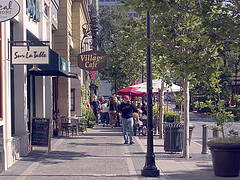Reinventing malls #2

Santana Row in San Jose, Calif. Photo from Slate. (My photo of Bowie Town Center isn't very good and I accidentally deleted all my photos of South Side Works in Pittsburgh.)
A couple days ago I mentioned the ULI publication, Ten Principles for Rethinking the Mall. National Retail Investor jumps on the bandwagon, with an article, "Reinventing Retail," about the same topic. Interestingly, according to the article:
Lifestyle centers can generate amazing returns. Jeffrey R. Anderson Real Estate Inc. of Cincinnati, a lifestyle developer, spent about $75 million building the 420,000 sq. ft. Geneva Commons lifestyle center in suburban Chicago. Less than three years after it opened in 2002, it sold for $125 million to an investment partnership that included Morgan Stanley.
Obtaining debt capital is a breeze. “Investing in these centers can be very lucrative,” says Mark Fallon, Anderson's vice president of real estate. His firm has been selling to buyers willing to pay prices based on a capitalization rate of 6% and even less. But he worries that too many developers and speculators think such success can be replicated anywhere.
Despite the risks, lenders are jumping on the mixed-use bandwagon. Developers report that banks and other institutions have been willing to finance 95% and even 100% of projects with substantial pre-leasing. They're even willing to bankroll office and hotel construction, too.
“Mixed-use historically has always carried more baggage in the eyes of lenders,” according to Jason Choulochas, west regional director for Wrightwood Capital LLC in Newport Beach, Calif. “But in the past five to seven years it's lost much of that stigma
Choulochas says mixed-use provides an opportunity for retail growth.“New retail projects have built-in customers from surrounding apartments, offices and hotels. That gives you great downside protection on your investment.”
---------------
Too bad that extant mixed-use doesn't enjoy the same appeal on the part of financiers. Getting financing for mixed use projects in cities, and for tenants that aren't chains, is much harder.
Also see
-- "Not a mall, it's a lifestyle center: Developers are embracing these cozy, high-end urban centers in lieu of traditional big box formats," from CNN;
-- "The Mall Goes Undercover: It now looks like a city street," from Slate; and
-- "Lifestyle Centers vs. Traditional Commercial Districts," by me, from Issue 48 of the Smart Growth America Newsletter.
You can't rest on your laurels, ever, because "From the standpoint of developers, they just want to build what's successful, and they are "commodifying", or monetizing the value of experience within the commercial retail environment."
As I said in February 2005, about Main Street programs, "We are all destination managers now!"

Charlottesville pedestrian mall. Photo: Charlottesville/Albemarle Convention & Visitors Bureau.



0 Comments:
Post a Comment
<< Home